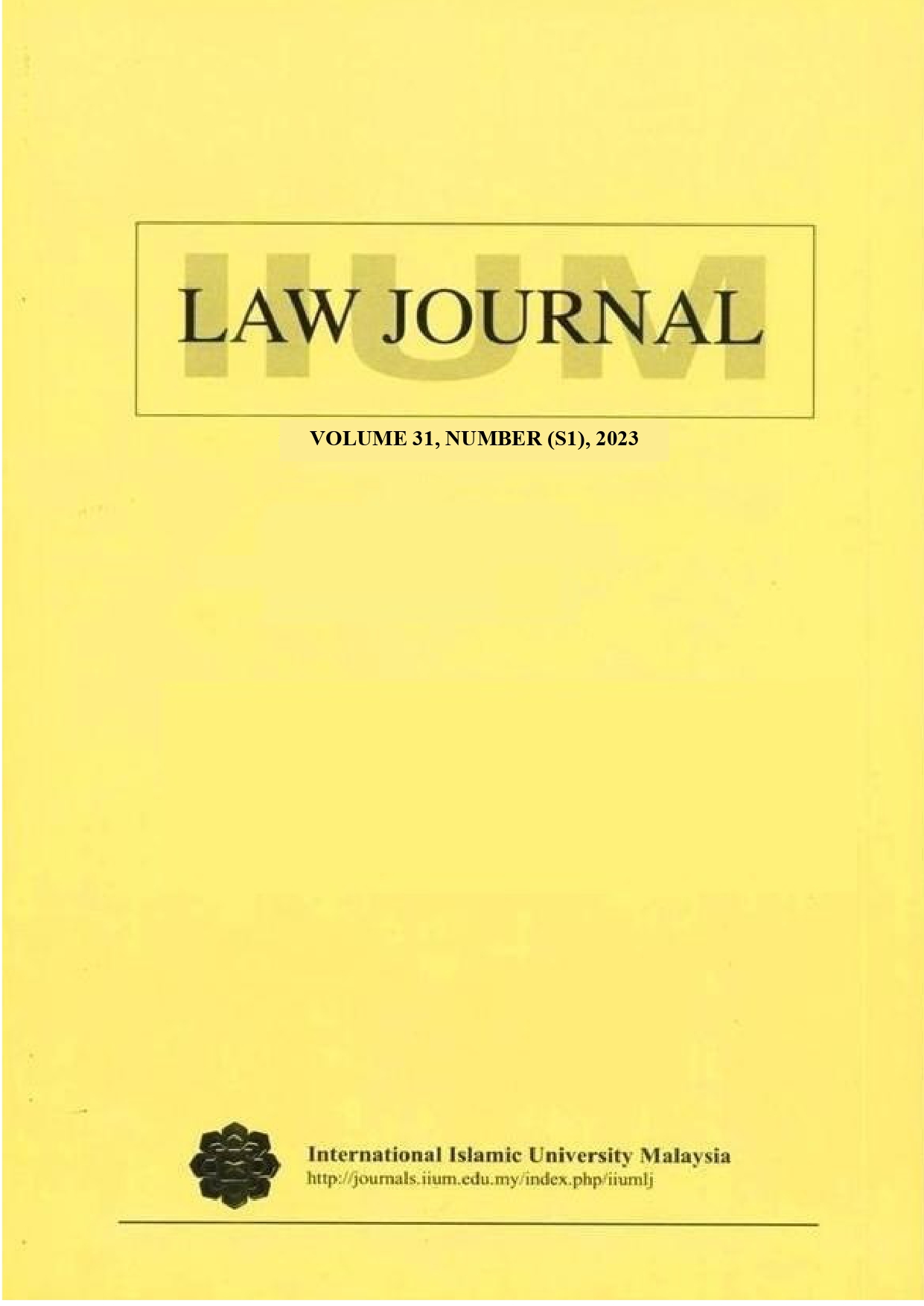APPLICATION OF PRINCIPLES OF CHAIN OF EVIDENCE AND CHAIN OF CUSTODY DURING STORAGE AND FORENSIC EXAMINATION OF ELECTRONIC DOCUMENTARY EVIDENCE IN SHARIAH CRIMINAL CASES IN MALAYSIA
DOI:
https://doi.org/10.31436/iiumlj.v31iS1.874Keywords:
Storage, Forensic Examination, Electronic Documentary Evidence, Admissibility, Shariah Criminal CasesAbstract
Electronic documentary evidence is submitted to prove the facts of the case and to assist the court in making a good judgment. Nevertheless, the admissibility of such evidence in Shariah criminal cases depends on the competence of religious enforcement officers in preserving the integrity of electronic documents during the process of storage and forensic examination at the investigation stage. Religious enforcement officers must ensure that both the chain of custody and chain of evidence remain intact during the conduct of both processes, so that both amply support the admissibility of the document during the trial later. However, Shariah texts make no reference to the processes of storage and forensic examination of electronic documentary evidence in ascertaining proof and strength of qarinah evidence. In addition, legal provisions in the enactment do not appear to make any reference to these principles and processes. Such a scenario has caused some confusion regarding their acknowledgment in determining the admissibility of electronic documentary evidence in the Shariah court. This article uses a legal research framework developed qualitatively, with library research method used in data and information collection. These data and information are subsequently analysed using content analysis and critical analytical methods. The article aims to identify the principles of Islamic evidence and legal provisions under the Shariah Criminal Procedure Enactment and analyses existing problems relating to the process of storage and forensic examination of electronic documents. It suggests that a standard operating procedure on the processes of storage and forensic examination of electronic documentary evidence be developed in addressing issues relating to the integrity and admissibility of electronic documentary evidence in Shariah criminal trials.
Metrics
References
Abdul Rahman, Mazupi and Mohd Shariff, Ahmad 'Azam. “The Scope and Application of Similar Fact Evidence under the Evidence Act 1950: Introduction and its Overview from the Perspective of Islamic Law of Evidence,” JUUM 7 (2003): 83-84, https://ejournal.ukm.my/juum/issue/view/590.
Auda, Jasser. Maqasid Al-Shariah as Philosophy of Islamic Law (Kuala Lumpur: Islamic Book Trust, 2010), 3.
Hayat, Shaukat. “The Decision by A Judge on the basis of his Personal Knowledge,” IIUM Law Journal 19, no. 2 (2011): 268, https://doi.org/10.31436/iiumlj.v19i2.10.
Ibn al-Qayyim, al Turuq al-Hukmiyyah fi al-Siyasah al-Syariyyah, (Qaherah: Matbaah al Sunnah al-Muhammadah,1953), 3-24.
Ibnu Qayyim Al- Jauziyah, Turuq al Hukmiyyah fi al Siyasah al Syar’iyyah (Al-Muassasah al-Arabi, 1961).
Islam, Md. Zahidul, Sonny Zulhuda, Nor Hafizah Mohd Badrol Afandi and Mohamed Affan Shafy. “Ensuring Safe Cyberspace for Children: An Analysis of the Legal Implications of Social Media Usage in Malaysia and Singapore,” IIUM Law Journal 28, no. SI (2020): 395, https://doi.org/10.31436/iiumlj.v28i(S1).591.
Maen Mohammad Ali S. Al-Qassaymeh, “The Evidential Weight of The Electronic Document under Jordanian Law: An Overall Comment,” IIUM Law Journal 19, no. 2 (2011): 290, https://doi.org/10.31436/iiumlj.v19i2.11.
Mohd Shariff, Ahmad Azam, Mohamad Azhan Yahya, Ramalinggam Rajamanickam, Melissa Hsu Tzu-Hsin, Muhammad Muhaimin Mohd Subki, Nurasyraf Fahmi Azahari, Jeevitha Raja et al., “Prinsip Rantaian Jagaan dan Rantaian Keterangan: Keperluan kepada Pengiktirafan dan Pengaplikasian dalam Kes Syariah di Malaysia,” Journal of Muwafaqat 5, no. 1, (2022): 17-32, https://doi.org/10.53840/muwafaqat.v5i1.106.
Muhamad, Mohd Munzil, Ahmad Azam Mohd Shariff, Ramalinggam Rajamanickam and Mazupi Abdul Rahman. “Qarinah: Admissibility of Circumstantial Evidence in Hudud and Qisas Cases,” Mediterranean Journal of Social Sciences 6, no. 2 (2015): 142, https://doi.org/10.5901/mjss.2015.v6n2p141.
Principal Assistant Director, Legal, Trial and Appeal Division, Syariah Prosecution Department, Negeri Sembilan, “Gathering Electronic Document Evidence in Syariah Criminal Cases,” interview by Mohamad Azhan Yahya, February 26, 2018.
Sa’di, Mursilalaili Mustapa and Kamaruddin, Abdul Rani. “The Authenticity of Electronic Document under Islamic Law and Malaysian Law of Evidence,” Prosiding Seminar Kebangsaan Penyelidikan Pengurusan Hal Ehwal Islam Malaysia, 296.
Sa’di, Mursilalaili Mustapa, Abdul Rani Kamaruddin, and Zulfakar Ramlee, “Reception of Electronic Evidence from Islamic Perspective,” Australian Journal of Basic and Applied Sciences 9, no. 26 (2015): 30.
Saedon, Mahmud. An Introduction to Islamic Law of Evidence, (Shah Alam: Hizbi, 1996).
Yahya, Mohamad Azhan and Mohd Shariff, Ahmad Azam. “Memperkasakan Prinsip Syariah dalam Pengumpulan Keterangan Digital dalam Kes Jenayah Syariah.” Presented in 6th Muzakarah Fiqh & International Conference 2022 (6th MIFC 2022), 13th 7 14th December 2022, 27-33.
Yahya, Mohamad Azhan, Ahmad Azam Mohd Shariff, Azizah Mat Rashid and Fatimah Yusro. “Pengemukaan Dokumen Elektronik sebagai Keterangan dalam Perbicaraan Mahkamah Syariah,” JUUM 27 (2020): 59, https://doi.org./10.17576/juum-2020-27-06.
Yahya, Mohamad Azhan, Hammad Mohamad Dahalan, and Suhaizad Saifuddin, “Analisis Proses Pengumpulan Keterangan Dokumen Elektronik dalam Kes Jenayah Syariah,” ISLĀMIYYĀT 43, Isu Khas (2021): 18.
Zaidan, Abdul Karim. al Qadha fi al Syariah al Islamiyyah, (Baghdah: Matbaah al Ani, 1984)
Downloads
Published
How to Cite
Issue
Section
License
© Copyright 1993-2024 IIUM Press![]()
The IIUM Law Journal is licensed under a Creative Commons Attribution-NonCommercial 4.0 International License.
- Consent to publish: The Author(s) undertakes that the article named above is original and consents that the IIUM Press publishes it.
- Previous publication: The Author(s) guarantees that the article named above has not been published before in any form, that it is not concurrently submitted to another publication, and that it does not infringe anyone’s copyright. The Author(s) holds the IIUM Press and Editors of IIUM Law Journal harmless against all copyright claims.
- Transfer of copyright: The Author(s) hereby transfers the copyright of the article to the IIUM Press, which shall have the exclusive and unlimited right to publish the article in any form, including on electronic media. The Journal in turn grants the Author(s) the right to reproduce the article for educational and scientific purposes, provided the written consent of the Publisher is obtained.
















